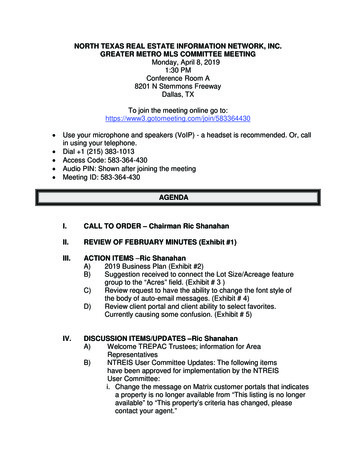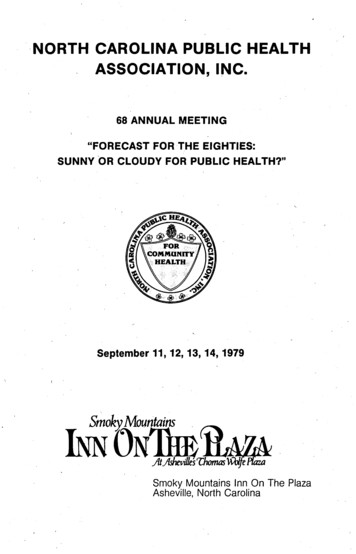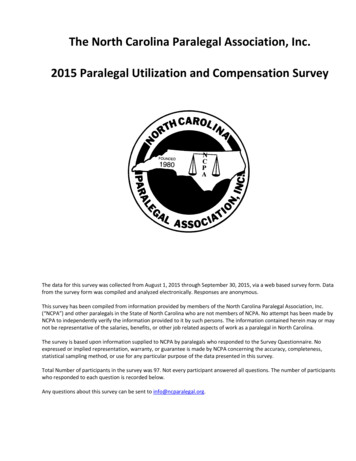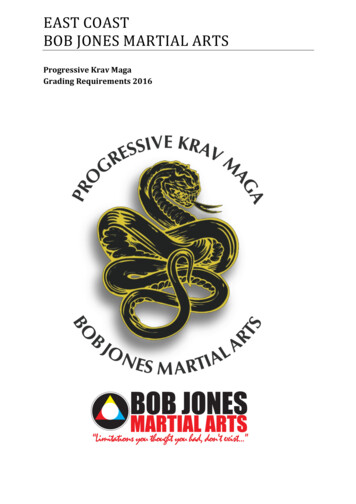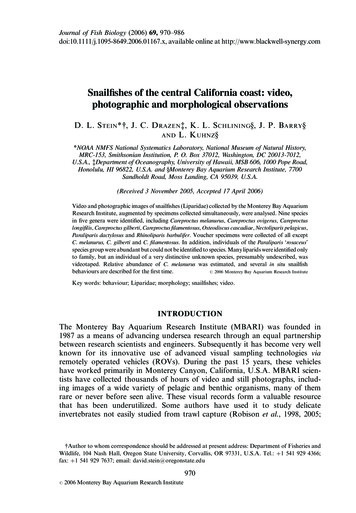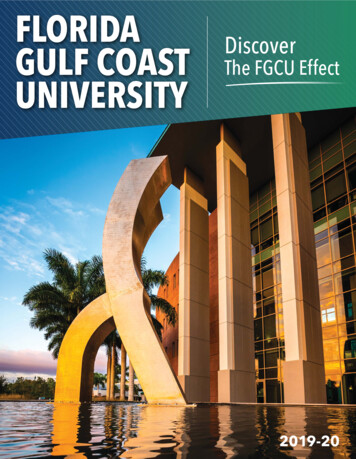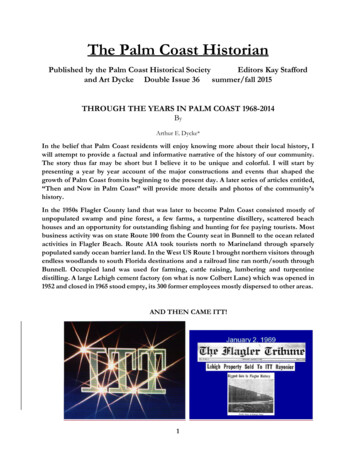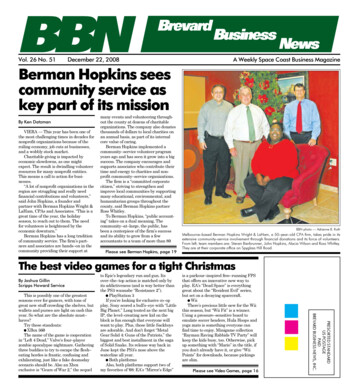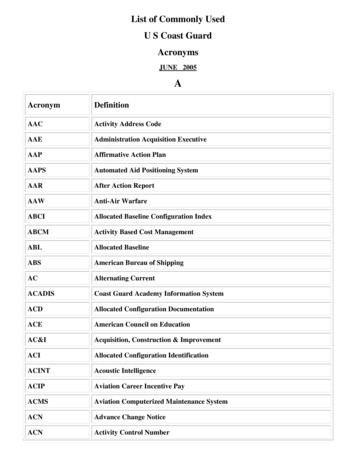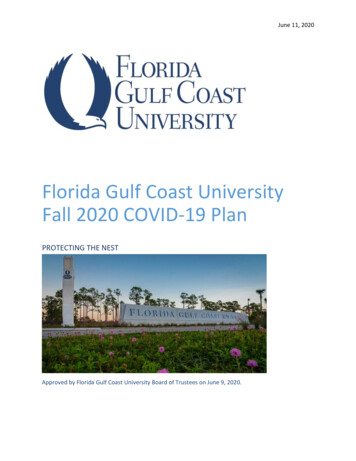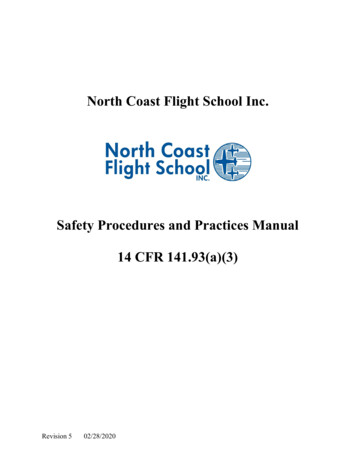
Transcription
North Coast Flight School Inc.Safety Procedures and Practices Manual14 CFR 141.93(a)(3)Revision 502/28/2020
Page 2 of 28Safety Procedures ManualLog of Effective 02/28/202001/14/2019I have reviewed the contents of this manual.Date Accepted:REV Control Date:Revision 502/28/2020Rev.44444454
Page 3 of 28Revision 3 03/15/2017
Table of ContentsLog of Effective PagesApplicabilityDefinitionsChain of CommandSection 1:EnrollmentCertificate of EnrollmentFlight Training CurriculumLesson PreparationStudent ProgressCourse CompletionMedicalSection 2:Operating RulesGeneral InformationSection 3:SchedulingSection 4:Weather LimitationsObtaining Weather InformationSection 5:Dispatching AircraftSection 6:Ground OperationsGeneralPre-flight ProceduresStarting ProceduresTaxiing ProceduresTakeoff ProceduresPost Flight ProceduresAircraft DiscrepanciesMaintenanceSection 7:Flight OperationsGeneralPractice AreaNight FlightsSolo Flight LessonsSection 8:SafetyCollision AvoidanceGeneralMinimum Altitude LimitationsSection 9:Cross Country FlightsApproved AirportsSection 10:Winter OperationsSection 11:Fuel Conservation and Mixture LeaningSection 12:Disciplinary ProceduresSection 13:Non-Instructional Aircraft RentalSection 14:Emergency ProceduresFire Precautions – In Case of FireAppendix A:Erie Airport 6171818181919192122222223232324
Page 5 of 28Applicability:Welcome to North Coast Flight School (NCFS)! We hope you will find your training andexperiences in this program to be exciting and motivating as you prepare for a career in aviation!Our goal at North Coast Flight School is to provide every student with thorough and professionalflight training.This manual gives both the student and the instructor some policies and procedures of NorthCoast Flight School. Following these policies and procedures will help make your trainingefficient, and safe.The regulations of this manual apply to all pilots and students who are enrolled in a part 141course of training at North Coast Flight School.This Safety Procedures and Practices Manual meets the requirements of 14 CFR 141.93(a)(3).All pilots are expected to comply with more restrictive or limiting regulations found in theFederal Aviation Regulations, or any State or Local regulations, in addition to the regulations ofthis manual.This manual is effective immediately. These regulations are subject to revisions and changeswhich can be made at any time. Any questions or comments regarding this manual, or requestsfor exemptions or changes, should be directed to the Chief Instructor.Definitions:ADVANCED STUDENT: A student who already has a Private Pilot certificate is considered anadvanced student.CROSS-COUNTRY: For the purpose of meeting aeronautical experience requirements,cross-country flight is a flight that includes a point of landing (touch-and-go, stop-and-go, or fullstop landing) at another airport that is at least a straight-line distance of more than 50 nauticalmiles from the departure airport. (low-approach only, or go-around does not qualify as alanding)DUAL: Flight instruction given to a student by an FAA Certificated Flight Instructor.EVALUATION:1 Excellent . Student demonstrates knowledge, risk management, and skills at leastequal to the instructor.2 Above Average . Student demonstrates knowledge, risk management, and skillsapproaching that of the instructor.Revision 401/14/2019
Page 6 of 283 Average . Student demonstrates knowledge, risk management, and skills exceedingthe minimum acceptable standards.Revision 401/14/2019
Page 7 of 284 Below Average . Student demonstrates knowledge, risk management, and skillsmarginally equal to the minimum acceptable standards .5 Below Acceptable Standards . Student demonstrates knowledge, risk management,and skills which do not equal the minimum acceptable standards.FLIGHT TRAINING: Training and aeronautical experience used to meet requirements for acertificate or rating.FLIGHT INSTRUCTOR: An approved North Coast Flight School Flight Instructor.INSTRUMENT: Flight instruction in which a student pilots the airplane solely by reference toinstruments in actual or simulated conditions.LOCAL: Dual, pilot-in-command, or solo flight conducted within 25 nautical miles of ERIAirport.NIGHT: Dual, pilot-in-command, or solo flight conducted between the end of evening civiltwilight and the beginning of morning civil twilight.OBSERVER: A person watching the wings and the tail of the airplane to verify clearance fromeverything as the airplane is being pulled or pushed.PRIMARY STUDENT: Any student that is working toward a Private Pilot certificate.RAMP: Any non-movement area on which flight school aircraft are parked or operated.RENTER: Anyone flying North Coast Flight School aircraft.R.O.N. OPERATIONS: Remain Over Night operations are conducted when an unplannedovernight stop is required at an airport away from home.SOLO: Flight in which a student pilot is the sole occupant of the airplane. Any flight conductedwithout an instructor on board.STAGE CHECK: Ground and flight lesson in which a student demonstrates to the checkinstructor or chief/assistant chief instructor the aeronautical knowledge, risk management,operational procedures, and flight maneuvers, as required by the objectives of that stage. Theseflights should be logged as dual and are to be included in the total time.STUDENT: Any person actively taking flight instruction at North Coast Flight School.Revision 401/14/2019
Page 8 of 28Chain of Command:President/Flight OperationsManager:Gregory HayesChief Instructor:Fred MorrisonAssistant Chief InstructorFlight InstructorsStudents / RentersSection 1 Enrollment1.1 Certificate of EnrollmentEach student will be provided with a certificate of enrollment containing the name of the courseand the date of enrollment.1.2 Flight Training CurriculumNorth Coast Flight School uses the Jeppesen Syllabi for organization of the flight trainingcurriculum of each course. These syllabi are used to provide the student with an outlook on theRevision 502/28/2020
Page 9 of 28upcoming flight and ground lessons and assure that all requirements for the issuance of thecertificates or ratings will be met.1.3 Lesson Preparation1.3.1 Prior to a flight lesson your instructor may assign material for you to study. In order tobenefit from each lesson, be sure to arrive prepared and have the assigned material read.1.3.2 During a pre-flight briefing, your flight instructor will discuss the objectives of the lesson.1.3.3 At the completion of the flight the instructor and student must conduct a post-flight briefingto review the flight. Any questions about the flight should be asked at this time.1.4 Student ProgressThe Chief Instructor monitors all student progress. Each course has stage checks that areadministered by either the Chief Instructor, Assistant Chief Instructor, or a Check Instructor.Successful completion of these checks is required to proceed to the next level of flight training.1.5 Course Completion1.5.1 Each student and instructor should pace themselves during the progress of a flight courseso that they complete the Private Pilot certificate by the end of the first semester and CommercialPilot certificate with an Instrument Rating by the end of the second year. Accomplishing thesegoals may require additional flying beyond the regular scheduled lessons.1.5.2 After successfully passing the final stage check and meeting all course completionstandards, your instructor will sign off your folder and log book. Prior to scheduling the practicalexamination with an approved examiner, the Chief Instructor will review your paperwork.1.6 Medical CertificateStudents must obtain at least a second class medical certificate within two weeks of beginningthe private pilot course. This can be obtained from an FAA appointed Aviation MedicalExaminer (AME).1.7 Student Pilot CertificateStudents must apply for a student pilot certificate within the first week of beginning the privatepilot course. Your instructor will help you with the online application at https://iacra.faa.govRevision 401/14/2019
Page 10 of 28.Section 2 Operating Rules2.1 General2.1.1 Students are not permitted behind the dispatch desk in the main office.2.1.2 The flight planning area is primarily a classroom. Be respectful of classes and otherinstructional activities being conducted there. Try to minimize thru-traffic in the classroom.2.1.3 General requirements for ground schoola. Students must report to class and be seated by the beginning of class.b. Required materials must be brought to the class (Books, E6B, Charts, etc.).c. Phones must be turned off. If a call is expected, the teacher should be notified. Classdisturbances will result in the phone being seized for the duration of the class or thestudent being removed and marked UNEXCUSED.d. A 10 minute break will be given every hour. Students are not excused to leave the schoolproperty without permission.e. Snacks and drinks are allowed in class at the instructor’s discretion. The area must bekept clean.2.1.4 General requirements for flight traininga.Students must arrive fifteen (15) minutes prior to scheduled block time.b.Phones should be placed on “airplane mode” during flight lessons.c.Except for bottled water, students are not allowed to eat or drink in school aircraft.2.1.5 Students must have the following in their possession during all flights:a. Pilot Operating Handbook for the aircraft to be flownb. Current medical or BasicMed certificatec. Logbookd. Certificates or licenses as appropriatee. Appropriate and current navigation and supplemental publicationsf. Headsetsg. Required performance and weight & balance datah. E-6B and plotter or electronic computeri. Notepad and Pencil (or Pen)2.1.6 All flights should monitor “fingers (123.45)” during flight training, except:a. As needed to comply with flight training conditionsb. If one radio is inoperable.Revision 502/28/2020
Page 11 of 28Revision 401/14/2019
Page 12 of 28Section 3 Scheduling3.1 Students are required to use Flight Schedule Pro (FSP). Dispatch will assist with accountsetup and training. Call dispatch if there is a problem using FSP.3.2 All NCFS students will be scheduled in the following manner:a. Students will be scheduled for a minimum of 3 lessons each week.b. Students will be scheduled based on certificate seniority on a first come/first serve basis.3.3 Students will not be scheduled for any flight training unless all registration requirementshave been met and the student’s account has a positive balance.3.4 University students are urged to participate in flight training during the summer months.3.5 Report time for all flight lessons is at least 15 minutes prior to flight. Any student reporting10 minutes past scheduled flight time will be considered a no-show.3.6 Students must cancel any lesson they cannot make at least 2 hours prior to the time thelesson is scheduled.Revision 401/14/2019
Page 13 of 28Section 4 Weather Limitations4.1 No aircraft shall be dispatched for VFR flight unless the following weather conditions aremaintained:DualLocalPatternX/C ayD1,500ft AGL/ 3sm1,500ft AGL/ 3sm2,500ft AGL/ 5sm ightN2,500ft AGL/ 5sm1,500ft AGL/ 3sm3,000ft AGL/ 5smDay2,000ft AGL/ 5sm.1,500ft AGL/ 3sm.4,500ft AGL/ 6sm.Night (not authorized for primary students)2,500 AGL/5sm1,500 AGL/3sm5,000 AGL/ 6smSoloLocalPatternX/C4.2 No aircraft shall be dispatched for IFR flight unless the following weather conditions aremaintained: The TAF for KERI within /- 1 hour of the return ETA must be at least 100’ aboveminimums for the expected approach procedure at Erie. Flight into known or forecasted icing conditions is prohibited.4.3 Primary student solo flights are restricted to a maximum of 15 knots headwind and 10 knotsof crosswind. A student may not fly solo with a gust factor greater than 5 knots. Maximumheadwinds and crosswinds for dual flights are at the instructor’s discretion.4.4 Obtaining Weather Information4.4.1 Each pilot must obtain weather information prior to each flight. This includes flights in thetraffic pattern, practice area, and dual instructional flights.Section 5 Dispatching Aircraft5.1.1 Renters will receive keys and the dispatch binder from dispatch prior to every flight. Allkeys and dispatch binders must be returned to dispatch at the end of each flight. At no timeshould a student take an aircraft that is not dispatched to them.5.1.2 Prior to the aircraft being dispatched for solo flight, a student’s instructor must review theflight planning and consent to the flight.5.1.3 Flight training aircraft will only be dispatched through the flight schedule system(FlightSchedulePro.com). Only North Coast Flight School Instructors shall conduct the flightinstruction.Revision 401/14/2019
Page 14 of 285.1.4 Dispatching Prioritya. Check ridesb. Stage checksc. Dual instructiond. Solo lessonse. Other renters5.1.5 All aircraft dispatched for solo training of primary students must be back on the ground atKERI by official sunset. Advanced students can be dispatched for night flight provided thefollowing conditions are met:a. Student is night current per Section 7.3.b. A dispatcher/instructor will be on duty to receive the keys and dispatch binder uponreturn, or receive approval from the flight instructor to leave the keys and dispatch binderin the desk in the office.Section 6 Ground Operations6.1 - General6.1.1 Non-powered ground handling of the aircraft is usually done by FBO line servicepersonnel. However, if flight school students or instructors need to move an aircraft, an observermust be present. Never attempt to move an aircraft alone unless authorized by an instructor.6.1.2 Prior to aircraft start-up, make sure that the control wheel lock, chocks, and tow bar haveall been removed and properly stowed inside the aircraft or removed from the ramp.6.1.3 Prior to starting the engine and for engine starting, all pilots shall refer to the checklistincluded in the airplane.6.1.4 At no time while the aircraft engine is running should anyone enter or exit the aircraft.Exceptions to this rule are: An instructor exiting an aircraft for student solo. An instructor assisting in the startup of an aircraft. A mechanic entering or exiting for troubleshooting purposes.6.1.5 No occupants shall be inside the aircraft during refueling operations.6.1.6 It is usually better to walk behind a parked aircraft that has the engine running rather thanin front of it. In any case, always exercise caution and try not to interrupt the pilot’s operations.6.2 – Pre-flight Procedures6.2.1 Each pilot in command shall, before beginning a flight, become familiar with all availableinformation concerning that flight. This information must include:Revision 401/14/2019
Page 15 of 28a. For a flight under IFR or a flight not in the vicinity of an airport, weather reports andforecasts, fuel requirements, alternatives available if the planned flight cannot becompleted, and any known traffic delays of which the pilot in command has been advisedby ATC. Check for TFR's.b. For any flight, runways lengths at airports of intended use, and following takeoff andlanding information.6.2.2 Verify that the appropriate documents (airworthiness certificate, registration, pilotoperating handbook (POH), and weight and balance data) are on board as well as the pilot’spersonal documents.6.2.3 Before departure, the aircraft’s oil must be at POH-specified levels.6.2.4 Prior to any flight, instructors and students must verify the status of the aircraft inspections,GPS/navigation database updates, VOR checks, Airworthiness Directives, life limited parts, andInstructions for Continued Airworthiness. No aircraft may be flown for training beyond the exactlimit of the 100 hour inspection.6.2.5 Each pilot is responsible for a thorough pre-flight inspection including, but not limited toaircraft airworthiness, determination of the proper loading of the aircraft, take-off & landingdistances, and fuel requirements for each flight.6.3 – Starting Procedures Before starting engine, turn beacon light onStarting procedures should be accomplished using the appropriate aircraft checklistPre-solo students must have an instructor on board before starting the engineHand propping is prohibited6.4 – Taxiing Procedures6.4.1 No person shall taxi an aircraft until they are sure that there is no danger of collision withany persons or objects.6.4.2 All aircraft shall be taxied at a safe and reasonable speed (15 knots. max).6.4.3 Aircraft awaiting take-off shall remain well clear of the hold-short line.6.4.4 All aircraft shall be taxied in the center of the taxiways.6.4.5 Taxiing on unimproved surfaces is prohibited without permission from your flightinstructor.6.5 Takeoff ProceduresRevision 502/28/2020
Page 16 of 286.5.1 Prior to entering the runway, a takeoff brief is required. The takeoff brief will include thefollowing: applicable V speeds, engine failure during takeoff run, engine failure after takeoffwith and without runway available for landing again, off airport landing considerations, andaltitude required before attempting a return to the airport.6.6 Post-Flight Procedures6.6.1 After each flight the aircraft must be properly secured. A properly secured aircraft willhave the following items completed:a. Nose wheel chockedb. Flight controls secured with gust lock or seat beltc. Aircraft times recorded in flight logd. Closed and latched doors, windows, and baggage doors on the aircraft(note – during warm, dry weather, the doors and/or windows may remain open at theinstructor’s discretion)e. Master switch is off.Additional items for last flight of the daya. All doors, windows, and baggage doors must be securely closedb. Tie down the aircraft or call line service to have aircraft moved into a hanger6.6.2 Complete logbook entries and the training folder.6.7 Aircraft Discrepancies6.7.1 Students and Flight Instructors shall record any aircraft discrepancy. If an aircraftdiscrepancy, inoperative instrument or equipment, or mechanical irregularity is discovered,whether it is during preflight, inflight, or post-flight, the aircraft operator shall cause adiscrepancy “write-up” to occur in the aircraft maintenance record and presented to FlightOperations. The discrepancy entry will include:a. An accurate description of the discrepancyb. The location or leg where the discrepancy occurredc. The name, signature, certificate number and kind of certificated held by the PIC.d. The date6.7.2 Flight Operations shall display the aircraft as out of service and coordinate the appropriatemaintenance action. Flight operations will then arrange for the appropriate maintenance action tobe performed prior to future dispatch. Before the aircraft is flown again, including postmaintenance return to service flights, the discrepancy shall be corrected, or deferred IAW 14CFR Part 91.213d, and properly documented in the aircraft maintenance record. As per 14 CFRPart 43.9, proper documentation of corrective action will include:a. A description of the work, performed or a reference to the data used to perform thework.b. The date the corrective action was completed and aircraft total time in serviceRevision 502/28/2020
Page 17 of 28c. The name of the person performing the work if other than the person approving thework and return to service of the aircraft.d. The signature, type of certificate and certificate number of the person approving thework and return to service of the aircraft.6.7.3 If maintenance is deferred IAW 14 CFR Part 91.213d, a duplicate disc
Feb 28, 2020 · Your instructor will help you with the online application at https://iacra.faa.gov Revision 4 01/14/2019 . . Section 2 Operating Rules 2.1 General 2.1.1 Students are not permitted behind the dispatch desk in the main office. 2.1.2 The flight planning area is primarily a classroom. Be respectful of classes and other
